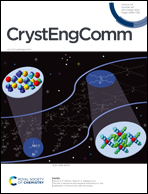A 3,8-connected Cd(ii)-based metal–organic framework as an appropriate luminescent sensor for the antibiotic sulfasalazine†
Abstract
The increasing use of antibiotics in our society is now another source of aquatic pollution as these antibiotics now exist in wastewater discharge. Therefore, it is necessary to identify this class of harmful components present in wastewater discharge. Metal–organic frameworks (MOFs) are a peculiar class of multidimensional materials that can be employed as sensors to selectively and sensitively detect the antibiotics that are present in wastewater discharge. Herein, a stable Cd(II)-based MOF, with the composition {[Cd2L(H2O)1.5]}n (1) (H4L = 4,5-di(4′-carboxylphenyl)phthalic acid), has been synthesized and characterized. Single-crystal X-ray analysis reveals that the MOF possesses a 3,8-connected topology with 1D channels occupied by lattice water molecules with the Schläfli symbol (3·51478·524). The MOF has been employed as a luminescent sensor to detect antibiotics in aqueous media. The results reveal that 1 sensitively detects trace amounts of the antibiotic sulfasalazine (SLA) up to 2.66 × 10−6 M via the decline in its emission intensity. Hence, 1 is an appropriate luminescent sensor for the SLA antibiotic in aqueous media. Further, attempts have been made to explain the sensing mechanism both experimentally and using theoretical calculations, which suggest that photoinduced electron transfer and competitive absorption are responsible for the decline in the emission intensity of 1 in the presence of antibiotic analytes.



 Please wait while we load your content...
Please wait while we load your content...